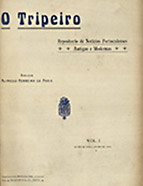

................................
A periodical like O Tripeiro stands out for its many unique features in the Portuguese publishing market, particularly among publications devoted to History. Although it cannot be fully classified as a historiographical journal—having been conceived and developed outside institutional academic circles—its original mission has been embraced and preserved by historians, enthusiasts, and the general public. This dedication has ensured the rare feat of celebrating the centenary of its brand. Between its foundation in 1908 and 1974, with natural intermissions and changes of editors who sought to maintain its identity, O Tripeiro saw six series published, spanning 36 years, 508 issues, and more than 11,000 pages. This track record certifies it as one of the finest examples of engaging and broad-reaching dissemination of Portuguese historiography, striking a balance between collective memory and scholarly erudition. From its very first issue, O Tripeiro was envisioned as a "repository of old and modern news from Porto," intended to perpetuate the cultural, patrimonial, social, and historical life of the city. While its primary focus remained on Porto, it never became insular. Whether through its transformation from a newspaper into a magazine or its broad, almost encyclopaedic scope, it now constitutes an invaluable legacy and one of the most comprehensive historical sources on Porto ( Invicta ) and its people. The publication also included entries relevant to neighbouring municipalities and the broader northern region, fostering a happy convergence of journalistic and academic articles. These spanned the past, present, and even reflections on the future, addressing a variety of topics in history, archaeology, ethnography, art history, and sociology.
Alfredo Ferreira de Faria (1867–1930) was the driving force behind the periodical, with these defining characteristics evident from the first series. He took over the title from another short-lived local publication, becoming both owner and director of the newly envisioned O Tripeiro: repositorio de noticias portucalenses [The Tripeiro : Repository of Porto News]. This quarterly newspaper’s inaugural year (1908–1909) consisted of 36 issues, which quickly gained national circulation. Faria himself contributed most of the articles, often presenting simple transcriptions of press reports or excerpts from books by both contemporary and late historians and literary figures, such as Alberto Bessa, J. Gomes de Macedo, Pedro Victorino, Alberto Pimentel, and Silva Leal. Graphically, the periodical reflected the aesthetic preferences of the time: its covers prominently featured illustrations and lithographs by notable artists, alongside the city’s coat of arms and three mottos: Pelo Porto [For Porto] (Club Fenianos), Honra e Fama [Honour and Fame] (Club Girondinos), and Recordar-se, consolar-se [To Remember, to Console] (A. Herculano). The editorial in the first issue outlined its objectives, scope, and target audience, establishing a blueprint for future editions: "an evocation of the past, a display of the present, and a stimulus for future generations." The periodical covered historical events, the material and immaterial heritage of the city, and the aspirations, controversies, emotional scenes, and popular figures of Porto’s natural or adopted citizens. Its aim was to create a potential monographic collection about Porto. Additionally, the publication expressed a desire that these significant and reliable notes could serve as documentary material for the development of historiographical works or monographs on the city. It leveraged privileged access to the archives of the Porto and Vila Nova de Gaia councils to support these ambitions.
This work is financed by national funds through FCT - Foundation for Science and Technology, I.P, in the scope of the projects UIDB/04311/2020 and UIDP/04311/2020.
